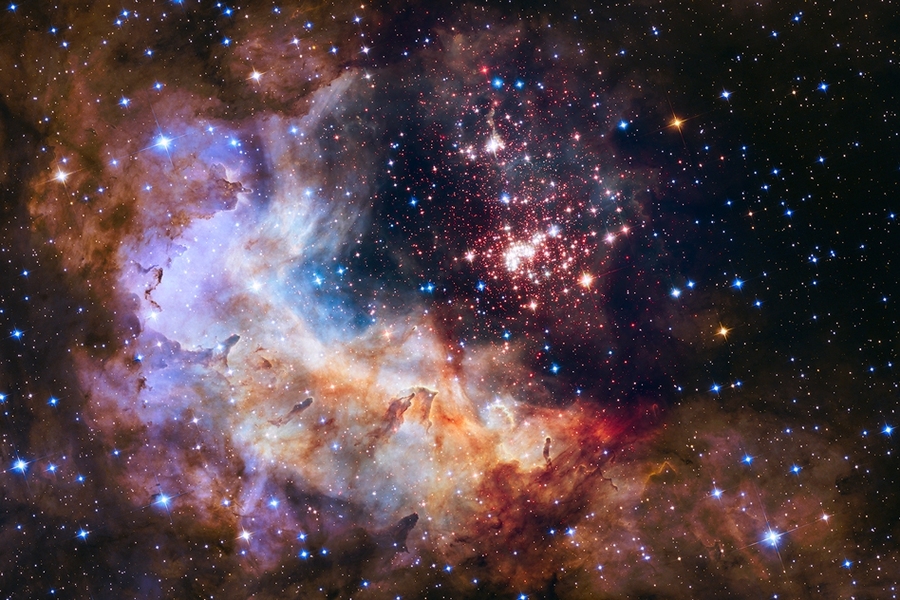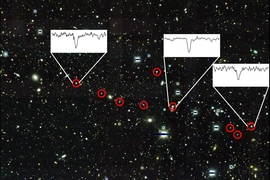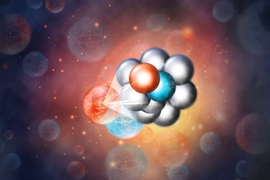Nearly all of the oxygen in our universe is forged in the bellies of massive stars like our sun. As these stars contract and burn, they set off thermonuclear reactions within their cores, where nuclei of carbon and helium can collide and fuse in a rare though essential nuclear reaction that generates much of the oxygen in the universe.
The rate of this oxygen-generating reaction has been incredibly tricky to pin down. But if researchers can get a good enough estimate of what’s known as the “radiative capture reaction rate,” they can begin to work out the answers to fundamental questions, such as the ratio of carbon to oxygen in the universe. An accurate rate might also help them determine whether an exploding star will settle into the form of a black hole or a neutron star.
Now physicists at MIT’s Laboratory for Nuclear Science (LNS) have come up with an experimental design that could help to nail down the rate of this oxygen-generating reaction. The approach requires a type of particle accelerator that is still under construction, in several locations around the world. Once up and running, such “multimegawatt” linear accelerators may provide just the right conditions to run the oxgen-generating reaction in reverse, as if turning back the clock of star formation.
The researchers say such an “inverse reaction” should give them an estimate of the reaction rate that actually occurs in stars, with higher accuracy than has previously been achieved.
“The job description of a physicist is to understand the world, and right now, we don’t quite understand where the oxygen in the universe comes from, and, how oxygen and carbon are made,” says Richard Milner, professor of physics at MIT. “If we’re right, this measurement will help us answer some of these important questions in nuclear physics regarding the origin of the elements.”
Milner is a co-author of a paper appearing today in the journal Physical Review C, along with lead author and MIT-LNS postdoc Ivica Friščić and MIT Center for Theoretical Physics Senior Research Scientist T. William Donnelly.
A precipitous drop
The radiative capture reaction rate refers to the reaction between a carbon-12 nucleus and a helium nucleus, also known as an alpha particle, that takes place within a star. When these two nuclei collide, the carbon nucleus effectively “captures” the alpha particle, and in the process, is excited and radiates energy in the form of a photon. What’s left behind is an oxygen-16 nucleus, which ultimately decays to a stable form of oxygen that exists in our atmosphere.
But the chances of this reaction occurring naturally in a star are incredibly slim, due to the fact that both an alpha particle and a carbon-12 nucleus are highly positively charged. If they do come in close contact, they are naturally inclined to repel, in what’s known as a Coulomb’s force. To fuse to form oxygen, the pair would have to collide at sufficiently high energies to overcome Coulomb’s force — a rare occurrence. Such an exceedingly low reaction rate would be impossible to detect at the energy levels that exist within stars.
For the past five decades, scientists have attempted to simulate the radiative capture reaction rate, in small yet powerful particle accelerators. They do so by colliding beams of helium and carbon in hopes of fusing nuclei from both beams to produce oxygen. They have been able to measure such reactions and calculate the associated reaction rates. However, the energies at which such accelerators collide particles are far higher than what occurs in a star, so much so that the current estimates of the oxygen-generating reaction rate are difficult to extrapolate to what actually occurs within stars.
“This reaction is rather well-known at higher energies, but it drops off precipitously as you go down in energy, toward the interesting astrophysical region,” Friščić says.
Time, in reverse
In the new study, the team decided to resurrect a previous notion, to produce the inverse of the oxygen-generating reaction. The aim, essentially, is to start from oxygen gas and split its nucleus into its starting ingredients: an alpha particle and a carbon-12 nucleus. The team reasoned that the probability of the reaction happening in reverse should be greater, and therefore more easily measured, than the same reaction run forward. The inverse reaction should also be possible at energies nearer to the energy range within actual stars.
In order to split oxygen, they would need a high-intensity beam, with a super-high concentration of electrons. (The more electrons that bombard a cloud of oxygen atoms, the more chance there is that one electron among billions will have just the right energy and momentum to collide with and split an oxygen nucleus.)
The idea originated with fellow MIT Research Scientist Genya Tsentalovich, who led a proposed experiment at the MIT-Bates South Hall electron storage ring in 2000. Although the experiment was never carried out at the Bates accelerator, which ceased operation in 2005, Donnelly and Milner felt the idea merited to be studed in detail. With the initiation of construction of next-generation linear accelerators in Germany and at Cornell University, having the capability to produce electron beams of high enough intensity, or current, to potentially trigger the inverse reaction, and the arrival of Friščić at MIT in 2016, the study got underway.
“The possibility of these new, high-intensity electron machines, with tens of milliamps of current, reawakened our interest in this [inverse reaction] idea,” Milner says.
The team proposed an experiment to produce the inverse reaction by shooting a beam of electrons at a cold, ultradense cloud of oxygen. If an electron successfully collided with and split an oxygen atom, it should scatter away with a certain amount of energy, which physicists have previously predicted. The researchers would isolate the collisions involving electrons within this given energy range, and from these, they would isolate the alpha particles produced in the aftermath.
Alpha particles are produced when O-16 atoms split. The splitting of other oxygen isotopes can also result in alpha particles, but these would scatter away slightly faster — about 10 nanoseconds faster — than alpha particles produced from the splitting of O-16 atoms. So, the team reasoned they would isolate those alpha particles that were slightly slower, with a slightly shorter “time of flight.”
The researchers could then calculate the rate of the inverse reaction, given how often slower alpha particles — and by proxy, the splitting of O-16 atoms — occurred. They then developed a model to relate the inverse reaction to the direct, forward reaction of oxygen production that naturally occurs in stars.
“We’re essentially doing the time-reverse reaction,” Milner says. “If you measure that at the precision we’re talking about, you should be able to directly extract the reaction rate, by factors of up to 20 beyond what anybody has done in this region.”
Currently, a multimegawatt linear accerator, MESA, is under construction in Germany. Friščić and Milner are collaborating with physicists there to design the experiment, in hopes that, once up and running, they can put their experiment into action to truly pin down the rate at which stars churn oxygen out into the universe.
“If we’re right, and we make this measurement, it will allow us to answer how much carbon and oxygen is formed in stars, which is the largest uncertainty that we have in our understanding of how stars evolve,” Milner says.
This research was carried out at MIT’s Laboratory for Nuclear Science and was supported, in part, by the U.S. Department of Energy Office of Nuclear Physics.








